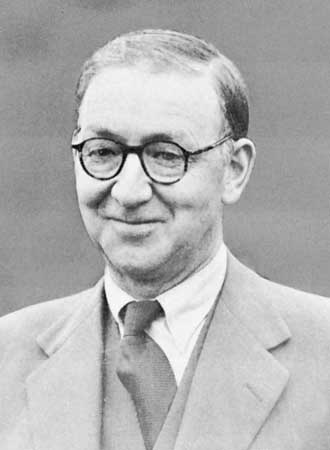<Back to Index>
- Physicist John Douglas Cockcroft, 1897
- Novelist Samuel Dashiell Hammett, 1894
- 7th President of Portugal Manuel Teixeira Gomes, 1860
PAGE SPONSOR

Sir John Douglas Cockcroft OM KCB CBE (27 May 1897 – 18 September 1967) was a British physicist. He shared the Nobel Prize in Physics for splitting the atomic nucleus with Ernest Walton, and was instrumental in the development of nuclear power.
Cockcroft was born in Todmorden, England, the eldest son of a mill owner. He was educated at Todmorden Secondary School (1909 – 1914) (where his physics teacher, Luke Sutcliffe, would later tutor another future Nobel Prize winner, Geoffrey Wilkinson) and studied mathematics at the Victoria University of Manchester (1914 – 1915). He was a signaller in the Royal Artillery from 1915 to 1918. After the war ended, he studied electrotechnical engineering at Manchester College of Technology from 1919 until 1920. Cockcroft received a mathematics degree from St. John's College, Cambridge, in 1924 and began research work under Ernest Rutherford. In 1929 he was elected a Fellow of St. John's College.
In 1928, he began to work on the acceleration of protons with Ernest Walton. In 1932, they bombarded lithium with high energy protons and succeeded in transmuting it into helium and other chemical elements. This was one of the earliest experiments to change the atomic nucleus of one element to a different nucleus by artificial means. This feat was popularly – if somewhat inaccurately – known as splitting the atom.
At the outbreak of the Second World War, he took up the post of Assistant Director of Scientific Research in the Ministry of Supply, working on radar. In 1944, he took charge of the Canadian Atomic Energy project and became Director of the Montreal Laboratory and Chalk River Laboratories, replacing Hans von Halban, who was considered a security risk. In 1946, he returned to Britain to set up the Atomic Energy Research Establishment (AERE) at Harwell, charged with developing Britain's atomic power programme. He became the first director of AERE. Even when leaving the post, he continued to be involved with Harwell. He was made a Commander of the Order of the British Empire in 1944, knighted in 1948, and created Knight Commander of the Order of the Bath in 1953.
As director of the AERE, he famously insisted that the coolant discharge chimney stacks of the Windscale plutonium production reactors be fitted, at great expense, with high performance filters. Since this was decided after the stacks had been designed, they produced iconic lumps in the shape of the structures. The reactors were designed to remain clean and uncorroded during use, so it was not considered that there would be any particulate present for the filters to catch. These filters therefore were known as Cockcroft's Folly right up until the Windscale fire, when the core of one of the two reactors caught fire in 1957, at which point the nickname fell out of favour. The filters prevented a disaster from becoming a catastrophe.
Cockcroft married Eunice Elizabeth Crabtree in 1925 and had four daughters and one son. He died at Churchill College, Cambridge, 18 September 1967; he is buried at the Parish of the Ascension Burial Ground in Cambridge. In 1951, Cockcroft, along with Walton, was awarded the Nobel Prize in Physics for his work in the use of accelerated particles to study the atomic nucleus. In 1959, he became the first Master of Churchill College, Cambridge. He was president of the Institute of Physics, the Physics Society, and the British Association for the Advancement of Science. Cockcroft served as chancellor of the Australian National University from 1961 to 1965. He received the American Atoms for Peace Award in 1961. He delivered the Rutherford Memorial Lecture in 1944. Today, five buildings in the United Kingdom are named after him: the Cockcroft building at the New Museums Site of the University of Cambridge, comprising a lecture theatre and several hardware laboratories; the Cockcroft Institute at
Daresbury Laboratory in Cheshire; the Cockroft Hall lecture theatre at
the Harwell Science and Innovation Centre; the Cockcroft building of the University of Brighton; and the Cockcroft building of the University of Salford. The oldest building at the Research School of Physical Sciences and Engineering, Australian National University, the Cockcroft building, is named after him. In the 1950s, the AERE commissioned a number of homes to be built in the nearby town of Didcot for
the many Harwell workers who lived there. The "focal" road of this
development in the south of the town (the one with the shops, school
and public house) is named Cockcroft Road.